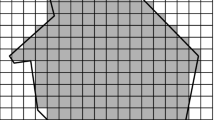Abstract
In pattern recognition and scene analysis, there are many occasions when we want to determine whether a digital arc is straight or not. For many applications such as the production of cartographic data bases, waveform analysis and perimeter estimation, it is preferable to access the curve as a set of connected straight lines or a polygonal line. Simple schemes for converting the digital curve into this form are useful.
Access this chapter
Tax calculation will be finalised at checkout
Purchases are for personal use only
Preview
Unable to display preview. Download preview PDF.
Similar content being viewed by others
References
Rosenfeld, A., Digital Straight Line Segments, IEEE Trans, on Computer, Vol C-23, No. 12, Dec. 1974, pp1264–1269.
Hung, S. H. Y. and Kasvand, T., Critical Points On A Perfectly 8- or 6-Connected Thin Binary Line, J. of Pattern Recognition, Vol.16 No.3, 1983, pp297–306.
Freeman, H., On the Encoding of Arbitrary Geometric Configuration, IRE Trans, on Electronic Computers, June 1961, pp260–268.
Wu, Li-De, On The Freeman’s Conjecture About the Chain Code of a Line, Proceedings of 5th International Conference on Pattern Recognition, pp32–34.
Hung, S. H. Y. and Kasvand, T., On the Chord Property and Its Application. To appear.
Author information
Authors and Affiliations
Editor information
Editors and Affiliations
Rights and permissions
Copyright information
© 1984 Springer-Verlag Berlin Heidelberg
About this paper
Cite this paper
Hung, S.H.Y., Kasvand, T. (1984). Segmentation of Digital Arcs. In: Brady, M., Gerhardt, L.A., Davidson, H.F. (eds) Robotics and Artificial Intelligence. NATO ASI Series, vol 11. Springer, Berlin, Heidelberg. https://doi.org/10.1007/978-3-642-82153-0_8
Download citation
DOI: https://doi.org/10.1007/978-3-642-82153-0_8
Publisher Name: Springer, Berlin, Heidelberg
Print ISBN: 978-3-642-82155-4
Online ISBN: 978-3-642-82153-0
eBook Packages: Springer Book Archive




